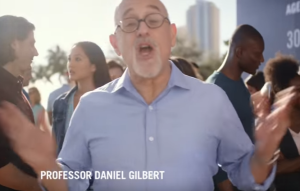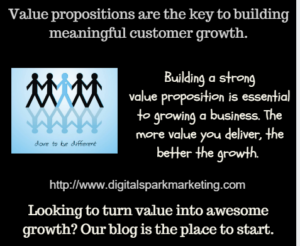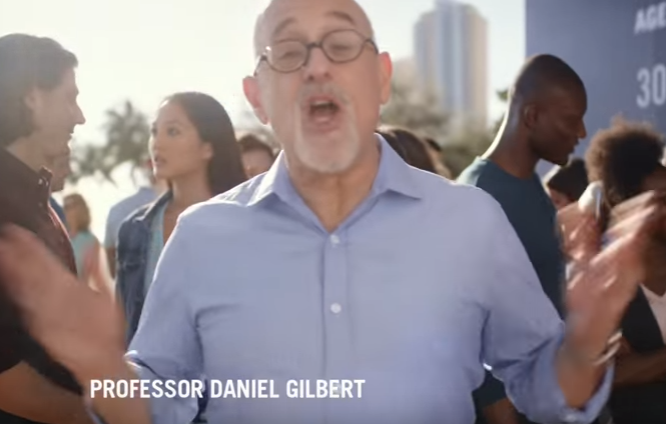Seth Godin : Conversations among the members of your marketplace happen whether you like it or not. Good marketing encourages the right sort of conversations. It is a simple concept. People don’t read ads, they read what interests them. So if you are going to generate advertising and design, you are going to have to create interesting copy. And, oh by the way, it must be more interesting than the millions of other advertisements out there. Now that is a daunting task, isn’t it? Prudential marketing has sought to overcome this dilemma with social advertising as its power of persuasion. Does it have the power to encourage the right sort of conversations?

Related post: Insurance Advertising War … 8 Examples to Learn From
Check out our thoughts on creative marketing.
Before we start, let me ask you a question.
Did you ever see a commercial that you liked and watched it? Can you remember the brand? We would love to hear what it was (OK to say you can’t remember the brand). Would you do us a favor and tell us in the comments section? It would be greatly appreciated by us and our readers.
According to Nielsen, there are 27,000,000 pieces of content are shared each day. And Statistic Brain says that our average attention span has dropped from 12 seconds in 2000 to 8 seconds – one second less than a goldfish!
We check our phones 150 times per day. We check our email up to 30 times an hour. And the amount of information in the world continues to double every 18 months.
All this available information and data is creating a battle for customer attention between brands, publishers, and every one of us who creates marketing content. But more importantly, it’s forcing businesses to think more and more as creative designers.
It has been said that advertising is the price to be paid for being unremarkable. That may be true, but I have noticed, despite the growth in on-line marketing, that even remarkable businesses also advertise the old fashion way. It is a key component of your marketing campaign, for awareness or consumer education of your value. If everyone is creating content, how does a business break through the noise? How do we reach our customers in a way that engages them?
Related post: A How-To Guidebook for Creating Winning Advertising
So what is advocacy advertising? It is a specific type of advertising that intends to promote a particular idea related to public discourse, viewpoints, and causes, in contrast to typical ads which intend to promote a product or a service.
Let’s examine 3 Prudential TV advocacy ads that are part of the Prudential marketing campaign:
Social advertising … the first ad
The first ad asks the audience several the questions:
How old is the oldest person you know?
How do you make sure you have enough money to enjoy all these retirement years?
The theme of this ad? Let’s get ready for a longer retirement. Makes you think about some crucial questions doesn’t it?
https://www.youtube.com/watch?v=zYRm89QOEf8
Social advertising examples .. the second ad
In the second ad, Prudential asked people:
If you could do something you really love, what would you do?
Your retirement should bring you to the answer. Prudential can help prepare you for retirement. Let’s prepare today to do what we love tomorrow.
https://www.youtube.com/watch?v=jdVop4AQqIk
In the third ad, Prudential ask customers how much money they would need in retirement. Trying to figure out exactly how much money you’ll need to retire is difficult. Let alone trying to make that amount last for potentially 30 or 40 years. Luckily, there is another way to think about planning for retirement. That is to approach things differently if we want to be ready for a long retirement. The theme here is: Together we can create retirement income that lasts.
https://www.youtube.com/watch?v=xZpjmBGIp44
Advocacy advertising is a specific type of advertising that intends to promote a particular idea related to public discourse, viewpoints, and causes, in contrast to typical ads which intend to promote a product or a service.
Prudential Financial, Inc.
Financial institutions like Prudential are difficult businesses to advertise in the traditional sense. Check out the words on their website:
For more than 135 years, Prudential Financial, Inc., has helped customers grow and protect their wealth. Today, we have been one of the world’s largest financial services institutions with operations in the United States, Asia, Europe, and Latin America. We also have one of the most recognized and trusted brand symbols: The Rock ®, an icon of strength, stability, expertise, and innovation. We strive to create long-term value for our stakeholders through strong business fundamentals, consistent with our mission guided by our vision and directed by our company’s core values. We are committed to keeping our promises and to doing business the right way.
But that is pretty difficult to discriminate in a way that is easily believed and remembered. So advocacy ads are a good substitute for effective advertising.
So, in summary, let’s examine Prudential’s TV ads in total, as key to the Prudential marketing campaign’s power of persuasion:

Social advertising … customer personalization
Messages and content
Ask questions to get the viewer thinking. So simple that the reader will quickly understand. Keep in mind that pictures are far more valuable than words. Use simple messages complemented with powerful visuals. Employ easy arguments. Easy arguments are the conclusions people reach using inferences without a careful review of available information. These ads clearly and simply get the messages across showing the before and after visuals.

Social advertising … appeal and visual attention
Present appeal that grabs and holds consumer attention.
Interesting information is the foundation and effective visuals hold the attention. Your ad messages must be appealing to your target communities.
Visual elements should be part of the story. The truth is that the processing capacity of our brains is limited and words may get in the way of emotionally powerful visual images. When powerful visual images dominate – when “a picture or video is worth a thousand words” – be quiet and let them do the talking.
Articles with images get 94% more views than those without. And posts with videos attract 3X more inbound links than plain text posts. A study by 3M showed that 90% of the information sent to the brain is visual, and visuals are processed 60,000 times faster than text.
Provide emotional connection
A good story does not interpret or explain the action in the story for the audience. Instead, it allows each member of the audience to interpret the story as he or she understands the action. This is why people find good stories so appealing and why they find advertising that simply conveys information boring.
Experiences that trigger our emotions are saved and consolidated in lasting memory because the emotions generated by the experiences signal our brains that the experiences are important to remember. In these ads, the questions posed add the emotions of humor, realness, surprise, and even a little fear. disgust.
Identifiable music
Match what viewers see with what they hear. People expect and prefer coordinated audio and visual messages because those messages are easier to process and understand.. Music can be a rapidly identified cue for the recall of emotional responses remembered from previous advertising. Making the same music an identifiable aspect of all advertising signals the audience to pay attention for more important content.
Call to action
A simple call to action is needed on all ads. Say exactly why people should contact your business and what you can do for them. For example “Come home to a life that is SIMPLY MAGNIFICENT.” Make the desired call to action a part of the story. A good story that is very entertaining but does not make a direct connection between the desired call to action and the story is just a very entertaining story. The whole point of the story in advertising is to effectively deliver the desired call to action. If the audience does not clearly understand the desired call to action after seeing the ad, then you are missing the real opportunity.
Related post: Successful Advertisement Design … 12 Best Examples to Study
Part of an integrated marketing campaign
Make your ad a component of an integrated marketing campaign. Proper spacing/timing are essential to the campaign. Swiffer has this element nailed in terms of ad frequency and mixing a variety of the ads so as not to annoy customers.
So if you remember one thing from this article, remember this:
Marketing or advertising, you need to create information that your customers find interesting and worth talking about and remembering.
Did you ever see a commercial that you liked and watched it? Can you remember the brand? We would love to hear what it was (OK to say you can’t remember the brand). Would you do us a favor and tell us in the comments section? It would be greatly appreciated by us and our readers.

So what’s the conclusion? The conclusion is there is no conclusion. There is only the next step. And that next step is completely up to you. But believe in the effectiveness of word of mouth marketing. And put it to good use.
It’s up to you to keep improving your creative marketing efforts. Lessons are all around you. In this case, your competitor may be providing the ideas and or inspiration. But the key is in knowing that it is within you already.
All you get is what you bring to the fight. And that fight gets better every day you learn and apply new lessons.
When things go wrong, what’s most important is your next step.
Try. Learn. Improve. Repeat.
Are you devoting enough energy improving your marketing, branding, and advertising?
Do you have a lesson about making your marketing strategy better you can share with this community? Have any questions or comments to add in the section below?
Mike Schoultz is the founder of Digital Spark Marketing, a digital marketing and customer service agency. With 40 years of business experience, he blogs on topics that relate to improving the performance of your business. Find them on G+, Twitter, and LinkedIn.
Digital Spark Marketing will stretch your thinking and your ability to adapt to change. We also provide some fun and inspiration along the way. Call us for a free quote today. You will be amazed how reasonable we will be.
More reading on marketing strategy from Digital Spark Marketing’s Library:
Ogilvy on Advertising … Best Lessons Learned from his Secrets
Volkswagen Ad … The Secrets to Its Effectiveness?
Effective Advertising … 14 Best Examples of Ad Design
Use 8 Breathtaking Commercials That Employ Emotional Appeal
Like this short blog? Follow Digital Spark Marketing on LinkedIn or add us to your circles for 3-4 short, interesting blogs, stories per week.
